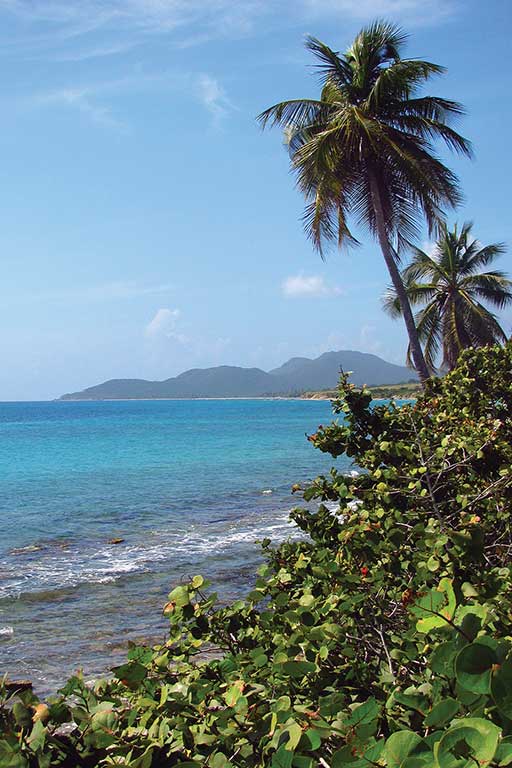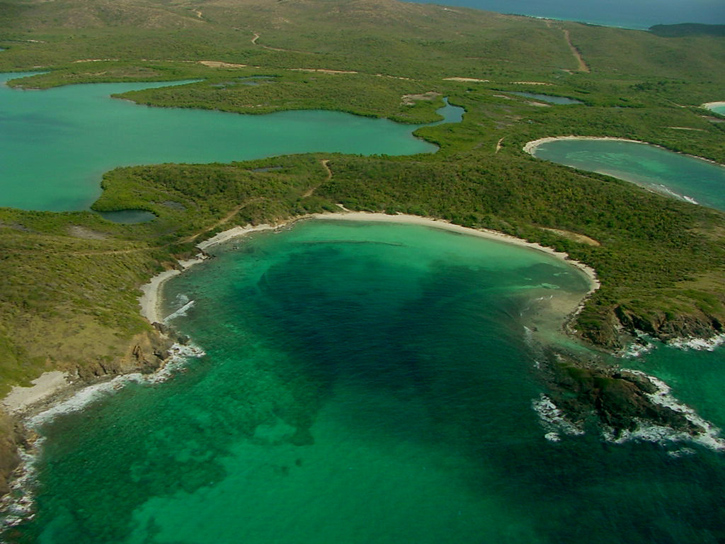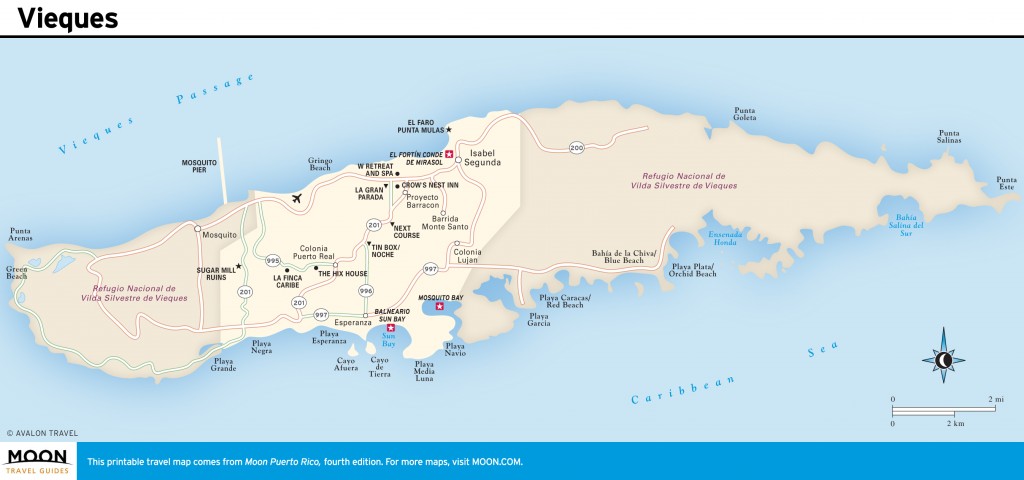In a world where change is constant, it’s nice to be reminded that some things stay the same. That is a big part of the charm of Vieques. Granted, a couple of new businesses have opened and a couple of them have closed. This hotel has changed names, and that one has a new coat of paint. But all in all, it’s still just a sleepy little island where life moves at a snail’s pace, cats and horses wander the island freely, and the only alarm clock you need is the crow of the roosters that run the place.

Vieques features miles of deserted beaches and bright blue water. Photo © Suzanne Van Atten.
The secret to enjoying Vieques is to chill out and let things unfold in their own way and time.Just 21 miles long and 5 miles wide, Vieques is a natural wonderland. It is rimmed with primitive, fine-sand beaches, untouched by commercial development, and coral reefs that teem with undersea life. Among the island’s mangrove forests is Mosquito Bay, one of the world’s most spectacular bioluminescent bays. No visit to Vieques would be complete without a boat ride through luminescent blue waters. Inland Vieques is thickly forested hills and arid stretches of desert-like land.Bats are the only animal native to Vieques, but other wildlife commonly found includes geckos, iguanas, frogs, pelicans, seagulls, egrets, herons, doves, and horses, of course. Horses are a common mode of transportation in Vieques, and they can be seen following the same traffic laws as automobiles, stopping at four-way stops and so on. But they also graze and roam freely. The waters around the island are home to several endangered species, including the manatee and a variety of sea turtles, which nest on the beaches at night. The eastern side of the island is still off-limits to visitors, as the Navy continues to remove vestiges of its presence here. And 60 percent of the island is a protected wildlife sanctuary—Refugio Nacional de Vida Silvestre de Vieques—managed by the U.S. Fish and Wildlife Service. Some of the island’s most beautiful primitive beaches are located here.

The secluded and undeveloped beaches of Vieques National Wildlife Refuge off the coast of Puerto Rico have been called some of the most beautiful in the world. Photo by Maritza Vargas/USFWS, © U.S. Fish and Wildlife Service Headquarters, licensed Creative Commons Attribution.
There are two primary communities on Vieques. On the north coast is Isabel Segunda, a.k.a. Isabel II, a traditional Puerto Rican town with a central plaza, an alcaldía (town hall), a post office, a grocery store, two banks—which contain the island’s only ATMs—and the island’s two gas stations. It is also where the ferry from Fajardo docks. There are a few shops, restaurants, and hotels here that cater to visitors, but Isabel Segunda is primarily a town where the island’s residents conduct their daily business.

Vieques
On the south coast is Esperanza, a funky, bohemian enclave where most tourists gravitate, thanks to the laid-back, “don’t worry, be happy” atmosphere and the proximity of Sun Bay, one of the most gorgeous publicly maintained beaches in all of Puerto Rico. The main hub of Esperanza is along the oceanfront stretch of Calle Flamboyan, distinguished by the picturesque malecón, a boardwalk with balustrades, benches, and pavilions. From here you can also see Cayo Afuera, a small islet in spitting distance with excellent snorkeling on the western side. On the opposite side of the street is an inviting array of casual, open-air bars and restaurants that overlook the water and grow lively with tourists and locals—many of them “expats” from the mainland—as sundown approaches. There are also a handful of boutiques and a couple of guesthouses in the area, as well as the Vieques Conservation and Historical Trust, a modest institution but a great source of information on the island.
There are a few things travelers should know when visiting Vieques. The island has one of the highest unemployment rates in the United States, and petty theft from parked cars is a continuing problem. When in town, visitors are encouraged to keep their cars locked at all times and never to leave anything visible inside. The greatest threat to car break-ins is at the beach. Drivers are encouraged to leave all the windows rolled down and the sunroof and glove box open to avoid having to pay the cost of replacing a broken window. And always park your car as close to you as possible—preferably away from any bushes and within sight range.
For well-heeled travelers, there are some outstanding and unique guesthouses that provide plenty of luxurious amenities. But outside those plush environs, there is a rustic quality to life here. Restaurants tend to be open-air, even nice ones, so don’t expect a respite from the heat and humidity at dinner. When using public facilities, plumbing issues require toilet paper be disposed of in trash receptacles instead of being flushed, which can make for an odorous experience. And if you think restaurant service is slow on the main island of Puerto Rico, you haven’t seen anything yet. Many businesses close or curtail hours during low season. Just when “low season” is can be a topic of debate. To be safe, assume it’s anything that isn’t high season, which everyone seems to agree is mid-November through April. In fact, assume all hours of operation are more suggestions than fact. The secret to enjoying Vieques is to chill out and let things unfold in their own way and time.
Excerpted from the Fourth Edition of Moon Puerto Rico.